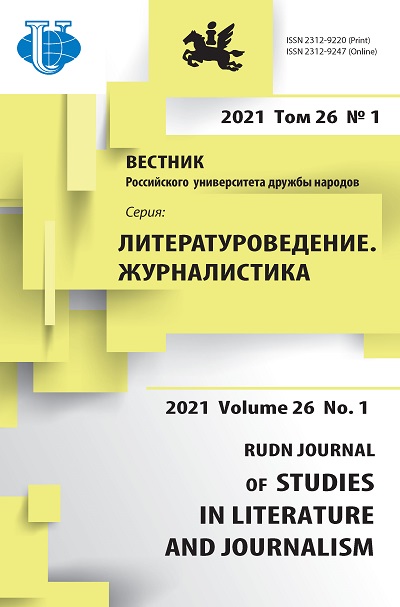TV Show Dramaturgy as an Analogue of the Audiovisual Syntax
- Authors: Kemarskaya I.N.1
-
Affiliations:
- Academy of Media Industry
- Issue: Vol 26, No 1 (2021)
- Pages: 99-106
- Section: JOURNALISM
- URL: https://journals.rudn.ru/literary-criticism/article/view/26082
- DOI: https://doi.org/10.22363/2312-9220-2021-26-1-99-106
Cite item
Full Text
Abstract
The dramaturgy of a television work as structure-forming for the format basis of a television periodical is examined. The purpose of the study is to explain the fundamental features of a TV program as an integral artistic phenomenon, embodied in many variations based on a single format model. The task is to clarify the problem of the effective functioning of syntactic rules in the absence of basic linguistic units, which is characteristic of the audiovisual language of screen shows, that has been actualized by domestic and Western media researchers. A general thesis is put forward about the polymodality of an audiovisual work as a single text, the unfolding of which occurs according to pre-established schemes that regulate the effect of individual elements on the viewer's perception. The dramatic approach is considered in the discourse of the global iconic turn from the verbal culture to the visual culture, there are multi-branch attempts to identify possible basic units of the new combinatorial sign system. Syntactic constructions, defined as a chain of episodes, show signs of fragmentation, mosaicism, intertextuality, and other criteria of postmodern aesthetics. The dualism of screen attractions as aggressively influencing instruments and verbal narrative, their mutual influence and dramatic significance are emphasized. The concepts of “syntactic uniformity”, the constancy of the syntactic structure chosen for a given format, without the possibility of breaking it in variations of editions are considered.
Keywords
About the authors
Irina N. Kemarskaya
Academy of Media Industry
Author for correspondence.
Email: ink0620@gmail.com
Candidate of Philology, leading researcher of the Research Sector
105 Octyabrskaya St, bldg 2, Moscow, 127521, Russian FederationReferences
- Mihalkovich, V.I. (1986). Izobrazitel'nyj yazyk sredstv massovoj kommunikacii [The pictorial language of mass communication]. M.: Nauka. (In Russ.)
- Bart, R. (1989). Izbrannye raboty. Semiotika. Poetika [Selected Works. Semiotics. Poetics]. Mocow, Progress Publ. (In Russ.)
- Vahshtajn, V.S. (2003). Dramaturgicheskaya teoriya Irvinga Gofmana: Dva prochteniya [Irving Hoffmann's dramatic theory: Two readings]. Sociologicheskoe Obozrenie [Sociological Review], 3(4), 104–118. (In Russ.)
- Van Dejk, T.A. (2000). Yazyk. Poznanie. Kommunikaciya [Language. Cognition. Communication]. Blagoveshchensk, BGK imeni I.A. Boduena de Kurtene. (In Russ.)
- Vojtik, E.A. (2013). Informaciya kak edinica kommunikativnogo processa i ee znachenie v mediakommunikacii [Information as a unit of the communicative process and its significance in media communication]. Bulletin of the Chelyabinsk State University], 1(292), 24–28. (In Russ.)
- Postnikova, T.V. (2006). Communication of cinema in semiotics of Yu.M. Lotman: Philosophical and anthropological analysis. Bulletin of Moscow University. Series 7. Philosophy, (3), 11–31. (In Russ.)
- Vartanova, E.L. (2019). K voprosu o vybore “edinicy analiza” v teoreticheskih mediaissledovaniyah [On the question of choosing a “unit of analysis” in theoretical media research]. Media v sovremennom mire. 58-e Peterburgskie chteniya [Media in the modern world. 58th Saint Petersburg Readings]: Collection of materials of the International Scientific Forum (April 18–19, 2019) (vol. 1, pp. 9–10). Saint Petersburg, SPbU Publ. (In Russ.)
- Gofman, E. (2003). Analiz frejmov: Esse ob organizacii povsednevnogo opyta [Frame analysis: An essay on the organization of everyday experience]. Moscow, Institute of Sociology of the RAS, Institut Fonda “Obshchestvennoe mnenie”. (In Russ.)
- Utilova, N.I. (2004). Montazh [Editing]. Moscow, Aspekt Press. (In Russ.)
- Lipkov, A.I. (1990). Problemy hudozhestvennogo vozdejstviya: Princip attrakciona [Problems of artistic impact: The principle of attraction]. Moscow, Nauka Publ. (In Russ.)
- Kozulyaev, A.V. (2019). Integrativnaya model' obucheniya audiovizual'nomu perevodu (anglijskij yazyk) [An integrative model of teaching audiovisual translation (English)] (Dissertation of the Candidate of Pedagogical Sciences). Mоscow, RUDN University. (In Russ.)
















